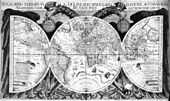Rudolphine Tables

The Rudolphine Tables (Latin: Tabulae Rudolphinae) consist of a star catalogue and planetary tables published by Johannes Kepler in 1627, using some observational data collected by Tycho Brahe (1546-1601). The tables are named as "Rudolphine" in memory of Rudolf II, Holy Roman Emperor.
Previous tables
Star tables had been produced for many centuries and were used to establish the position of the planets relative to the fixed stars (particularly the twelve constellations used in astrology) on a specific date in order to construct horoscopes. Until the end of the 16th century, the most widely used had been the Alphonsine tables, first produced in the 13th century and regularly updated thereafter. These were based on a Ptolemeic, geocentric model of the solar system. Although the Alphonsine tables were not very accurate, nothing else was available and so they continued to be used.[citation needed]
In 1551, following the publication of De revolutionibus orbium coelestium by Nicholas Copernicus, Erasmus Reinhold produced the Prutenic Tables based on a heliocentric model of the solar system, but these were no more accurate than the earlier tables.
Tycho's data and Kepler's model of the solar system
Tycho Brahe had spent much of his life obtaining measurements of the position of stars and planets to a much greater accuracy than had been possible previously. He wished these observations to be the basis of a new and more accurate set of star tables. Kepler was able to prepare these new tables using Tycho's accurate observations together with a heliocentric model of the solar system and his own discovery of the elliptical orbits of the planets. Accurate calculation was aided by the newly published system of logarithms which simplified accurate calculation and made them less prone to errors.
Publication

Tycho had intended that the tables should have a dedication to Emperor Rudolf II, but by 1627, when the tables were published, Rudolf II had died, so instead the tables were dedicated to Emperor Ferdinand II but are named after Rudolph II.[2] They contain positions for the 1,006 stars measured by Tycho Brahe, and more than 400 stars from Ptolemy and Johann Bayer, with directions and tables for locating the planets of the solar system. The tables included many function tables of logarithms and antilogarithms, and instructive examples for computing planetary positions.
For most stars these tables were accurate to within one arc minute,[3] and were the first to include corrective factors for atmospheric refraction.[4] The tables were sufficiently accurate to predict a transit of Mercury observed by Pierre Gassendi in 1631 and a transit of Venus observed by Jeremiah Horrox in 1639.[5]
See also
- Ferdinand Verbiest SECTION Astronomy contests
- Star cartography
- Urania Propitia
References
- ↑ Hannam, James (2011). The Genesis of Science: How the Christian Middle Ages launched the scientific revolution (1st American ed.). Washington, DC: Regnery. p. 294. ISBN 1596981555.
- ↑ Kusukawa, Sachiko (1999). "Kepler and Astronomical Tables".
- ↑ Tirion, Wil; Barry Rappaport; George Lovi (1992). Uranometria 2000.0 (1988 ed.). Richmond, Va.: Willmann-Bell. p. xvii. ISBN 0-943396-15-8.
- ↑ The New Encyclopædia Britannica, 1988, Volume 10, pg. 232
- ↑ Athreya, A.; Gingerich, O. (December 1996). "An Analysis of Kepler's Rudolphine Tables and Implications for the Reception of His Physical Astronomy". Bulletin of the American Astronomical Society 28 (4): 1305.
External links
- Universitätsbibliothek Kiel – Digiport: Tabulæ Rudolphinæ - Bartsch version from 1627, with appendices on Schiller's Christian constellations and Bartsch'es own constellation innovations.
- Johannes Kepler, Tabulae Rudolphinae
| |||||||||||